Doro Wat (Spicy Ethiopian Chicken Stew)
This post may contain affiliate links. See my disclosure policy.
There is a reason why Doro Wat is the national dish of Ethiopia and one of the most famous of all African dishes – it’s fabulous! This authentic Doro Wat recipe captures the very best of Ethiopian cooking!
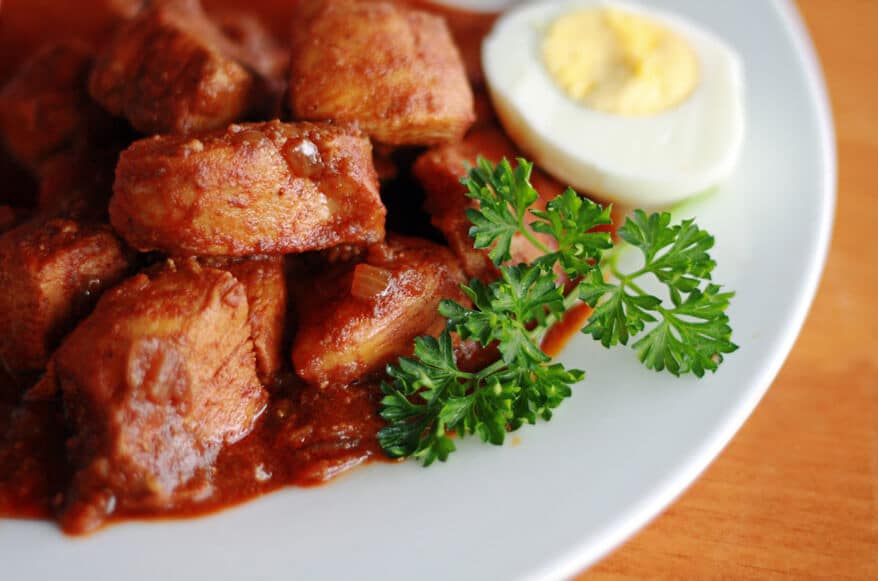
Doro Wat is one of the most famous of all African dishes. You will find it in every Ethiopian restaurant and virtually anyone who is familiar with African cuisine will have heard of it. Another version, though not as commonly known here, is Sega Wat, made with beef (fyi, you’ll find recipes online calling it Sik Sik Wat, but I’ve confirmed with the chefs of several Ethiopian restaurants that it’s Sega Wat). You can directly substitute beef for chicken and follow the same cooking instructions.
Doro Wat is traditionally made very spicy. Super spicy. Like I-don’t-know-how-Ethiopians-have-any-taste-buds-left spicy. Western adaptations are still spicy, but quite tame compared to the real deal.
This recipe for Doro Wat comes by way of request from Jared (Make a Request!). He said he has been trying for several years to find a good recipe. Jared, this recipe is both authentic and delicious – I think you’ll be very happy with it!
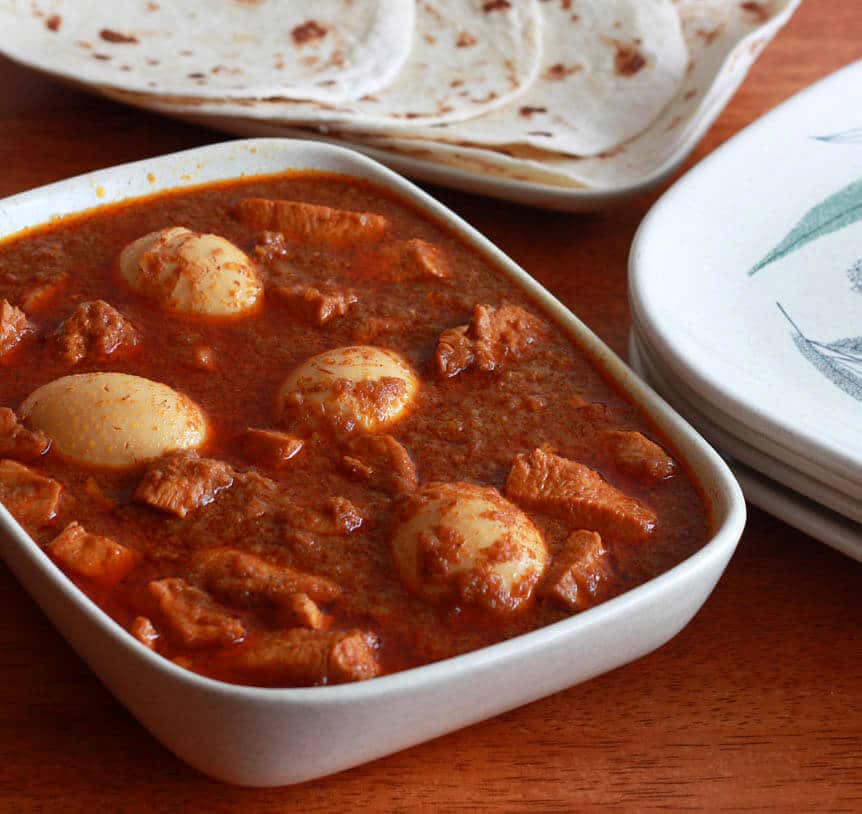
Traditionally Doro Wat is served with an Ethiopian flatbread called injera. It’s kind of a spongy pancake made with teff flour (a grain indigenous to the area), and the batter is left to ferment for up to 4 days before its used. The injera is used in place of an eating utensil and is used to scoop up the chicken stew.
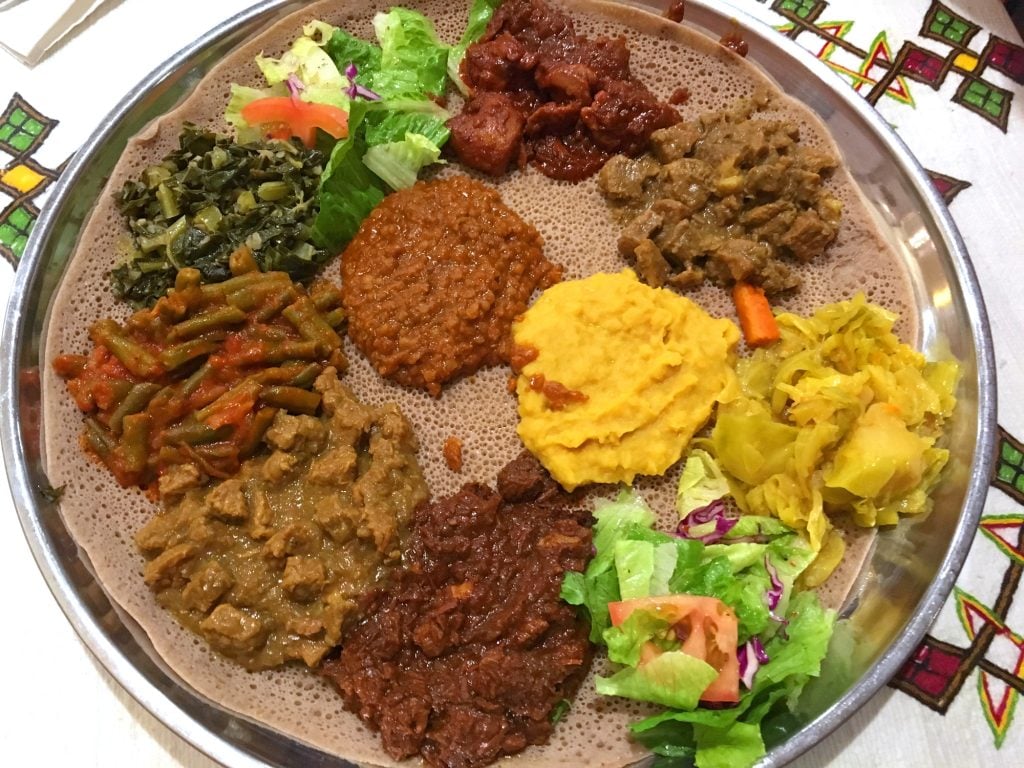
Doro Wat Key Ingredients
The key to authentic, great-tasting Doro Wat is good quality, flavorful berbere, and a very long cooking process. It can take several hours for an Ethiopian to make Doro Wat. You can cut back on the cooking time and your Doro Wat will still taste good, but it won’t taste like it’s supposed to. The magic is in the slow-cooked onions. And it takes time for the magic to happen.
A central ingredient of Doro Wat is Berbere, a fiery, bright red and flavorful Ethiopian spice blend. It is best made fresh using whole spices that are toasted and ground for maximum flavor. A combination of whole and ground spices are used as seen in the picture below.

The whole spices are toasted and ground up with the already ground spices to make a beautiful, aromatic, flavorful and spicy seasoning blend.
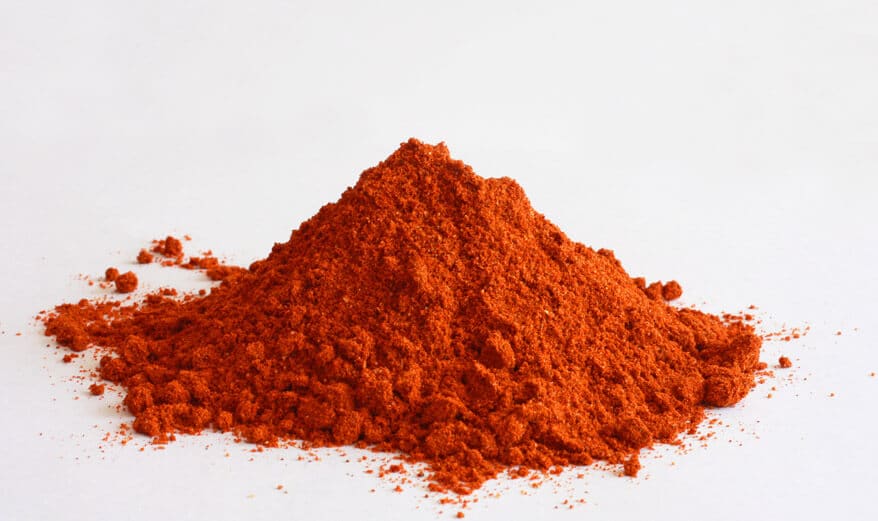
Purchasing these spices will serve you well as each of them are commonly used in a large variety of other cuisines. Stored in airtight glass jars in a dark place, they will keep a very long time. If you’d rather purchase berbere, you can find it online. You need 1/4-1/3 cup for this recipe alone, so forget the tiny 2-3 oz jars of it you usually find for sale. The best deal I’ve found for bulk berbere (and it also happens to be organic and a reputable brand) can be found HERE.
Berbere makes a great rub for meat, poultry, and fish, as well as a seasoning for stews, soups, and vegetables. It’s a great all-purpose spice, so you’ll be able to make good use of this bulk package if you decide to buy versus make your own.
Another key ingredient in Doro Wat and Ethiopian cooking at large is niter kibbeh, a seasoned clarified butter. You can find it in Indian grocery stores and well-stocked Asian markets, but as always I strongly recommend making your own for the best flavor. Check out my recipe for homemade Niter Kibbeh!

Doro Wat Recipe
Let’s get started!
Use a food processor to very finely mince the onion – you want an almost chunky puree.
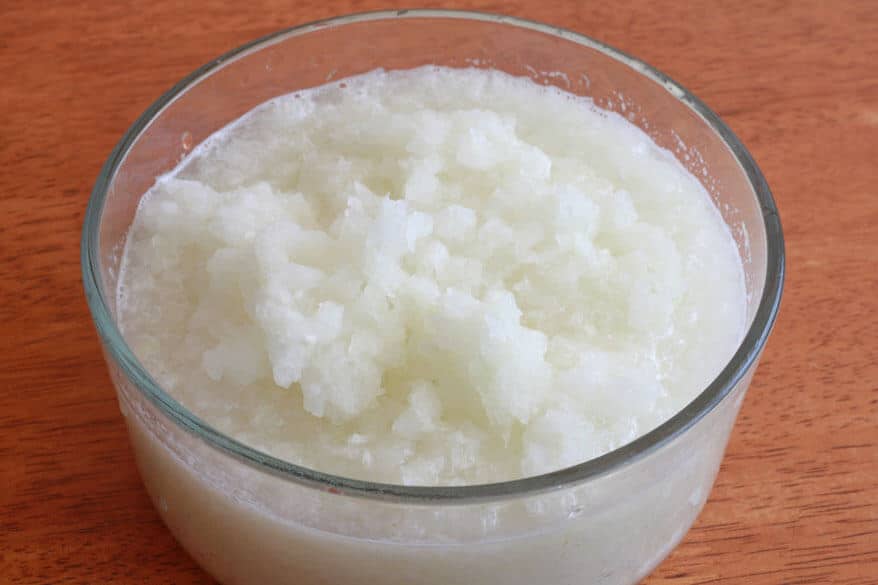
Heat 2 tablespoons of oil and 2 tablespoons of niter kibbeh in a Dutch oven and saute the onion, covered, over low heat for 45 minutes, stirring occasionally. Add more niter kibbeh if it gets too dry.
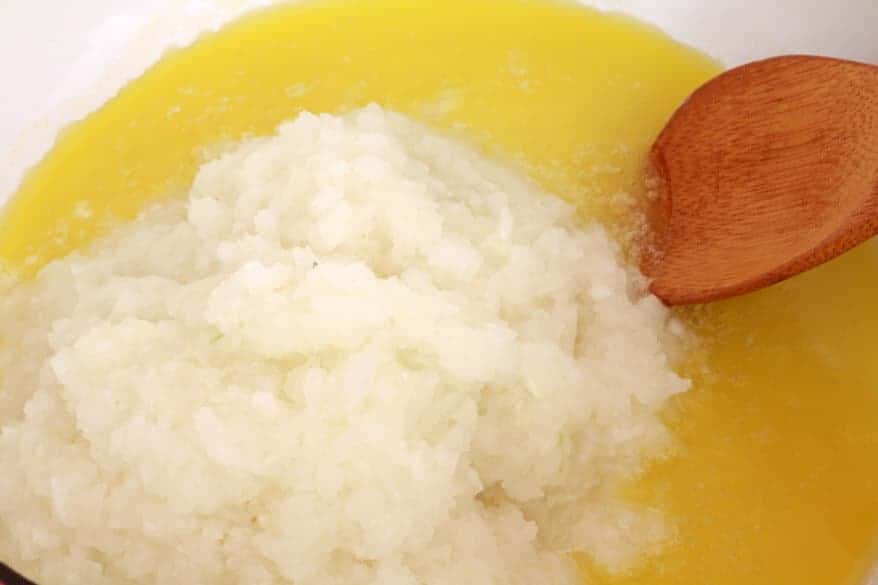
In the meantime, finely mince the garlic and ginger.
Add the garlic, ginger, and 1 tablespoon of butter. Continue to saute, covered, over low heat for another 20 minutes, stirring occasionally.
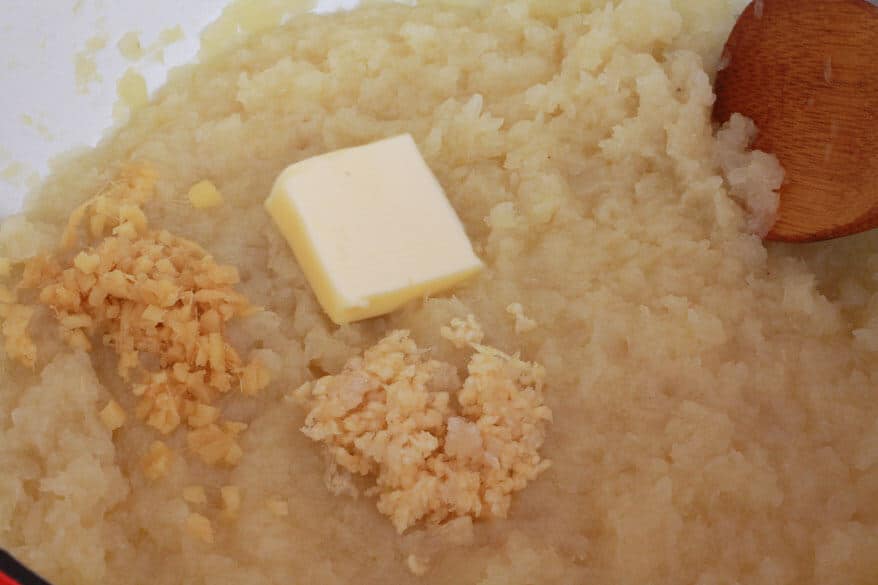
Add 4 tablespoons of berbere and 2 teaspoons salt and stir to combine.
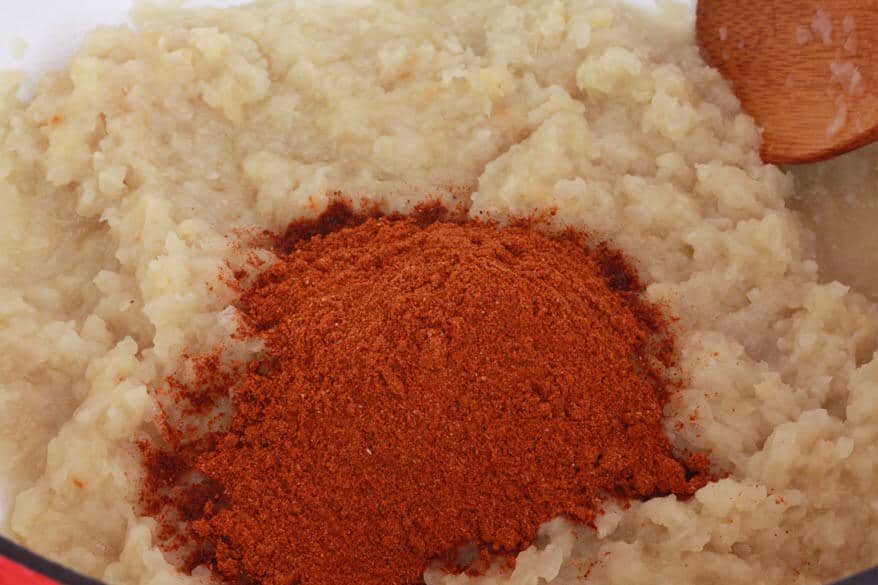
Add 2 tablespoons of butter, cover, and simmer over low heat for another 30 minutes, stirring occasionally.
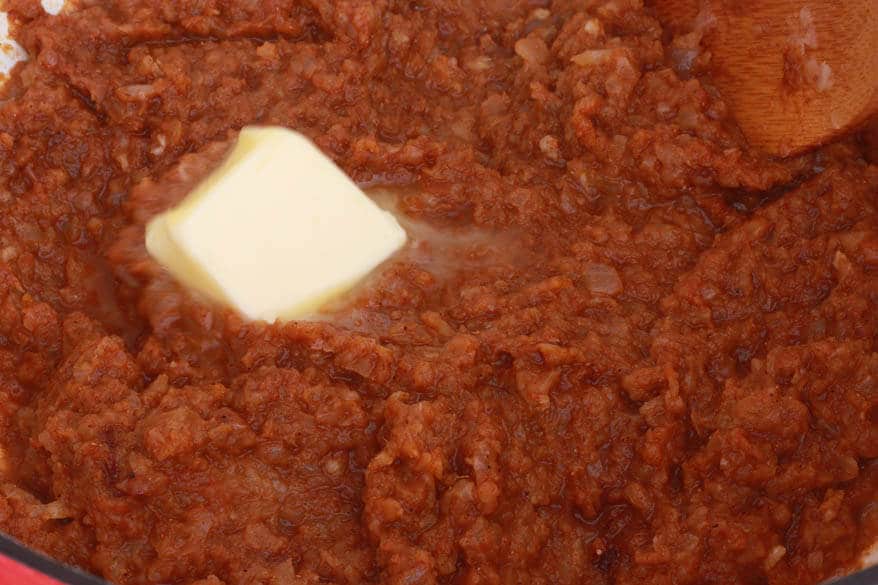
After 30 minutes you’ll have a rich and luscious sauce that’s ready for the chicken!
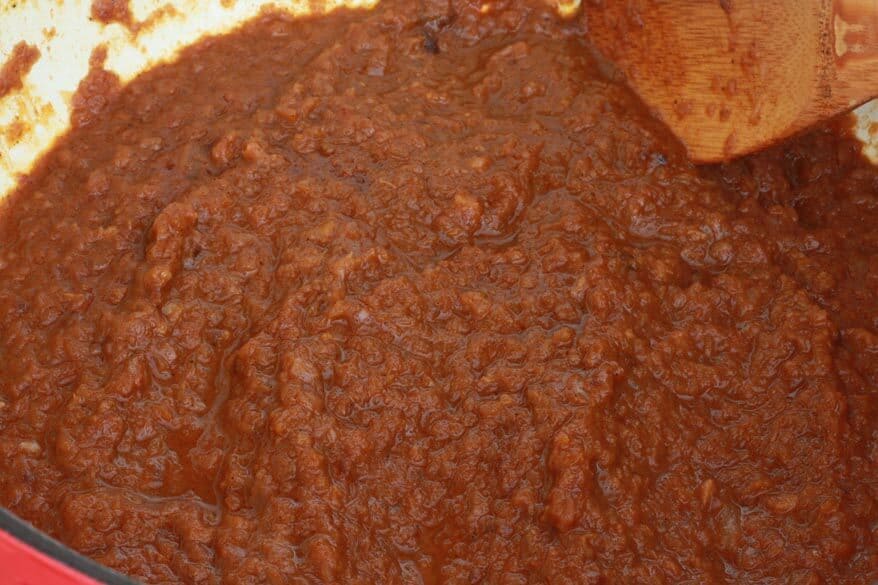
Traditionally, bone-in, skin-on chicken pieces are used. You can either use chicken thighs, cut into 1 inch chunks, or use boneless chicken breast. I used breast this time. Cut the breast into small, 1/2 inch chunks. Place the chunks in a dish with 2 tablespoons lemon juice and let sit at least 15 minutes.
Add the chicken to the sauce.
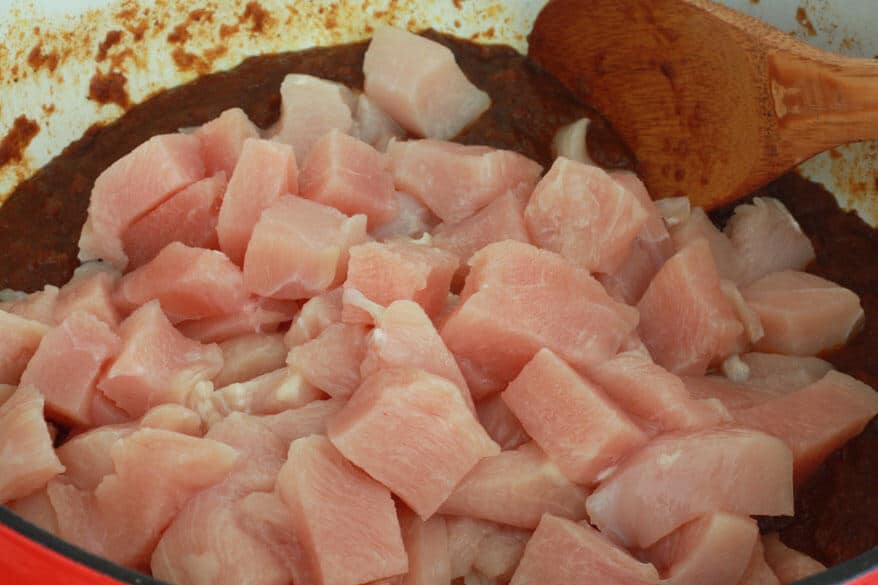
Traditionally, Tej is used, an Ethiopian honey wine. If you have access to it, use it. Alternatively you can substitute white wine with a teaspoon of honey.
Add the chicken stock, salt and honey wine to the mixture. Bring to a boil, reduce the heat to low, cover, and simmer for 45 minutes, stirring occasionally.
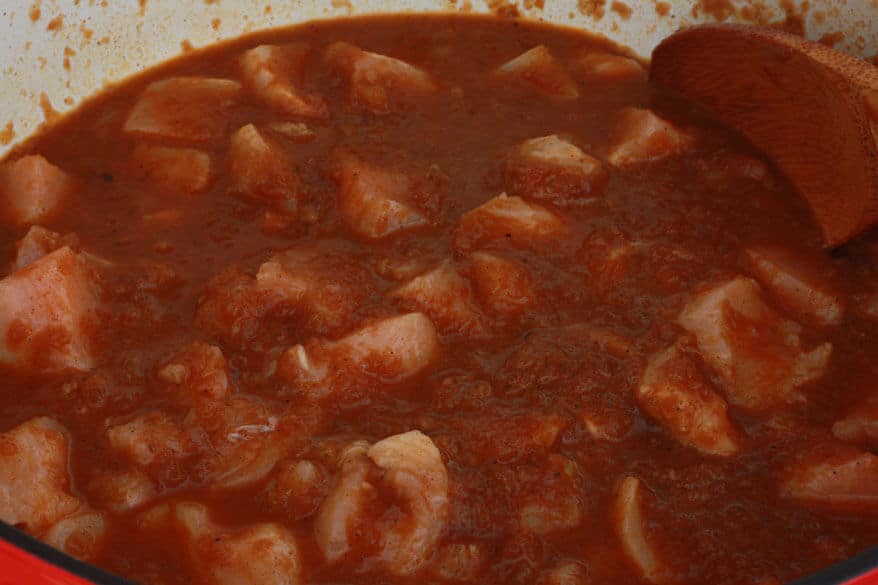
In the meantime, boil the eggs. Once the eggs have cooled enough to handle, peel and pierce them all over with a fork, about 1/4 inch deep, to allow the sauce to penetrate.
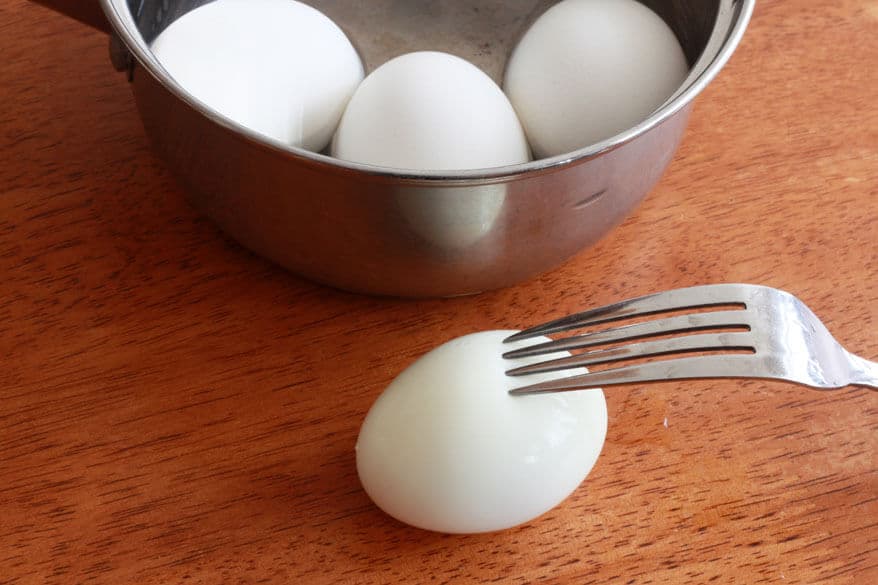
After 45 minutes you’ll have a rich, luscious spicy chicken stew ready for the eggs!
Add the eggs and continue to simmer, covered, over low heat for 15 minutes, stirring occasionally. Adjust the seasonings according to taste. Add more berbere according to heat preference.
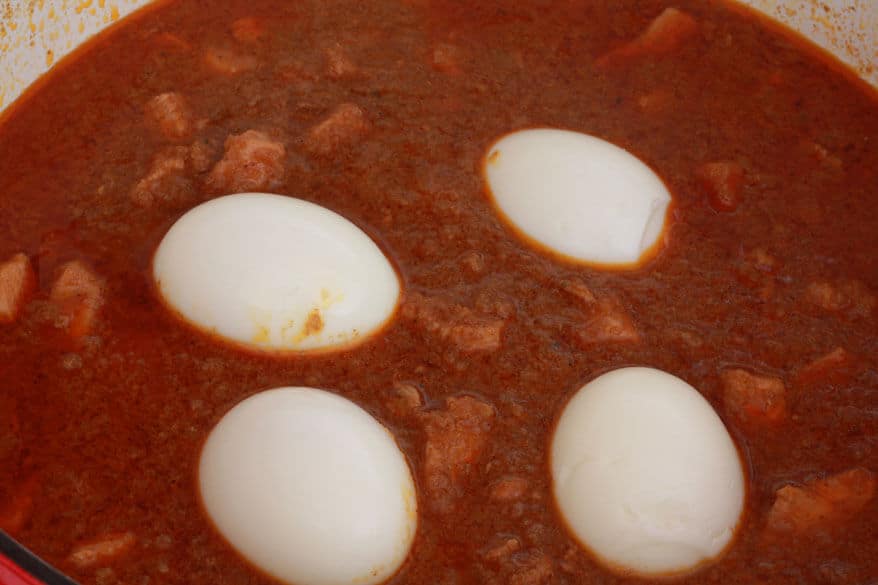

Serve with Authentic Injera (Ethiopian Flatbread).
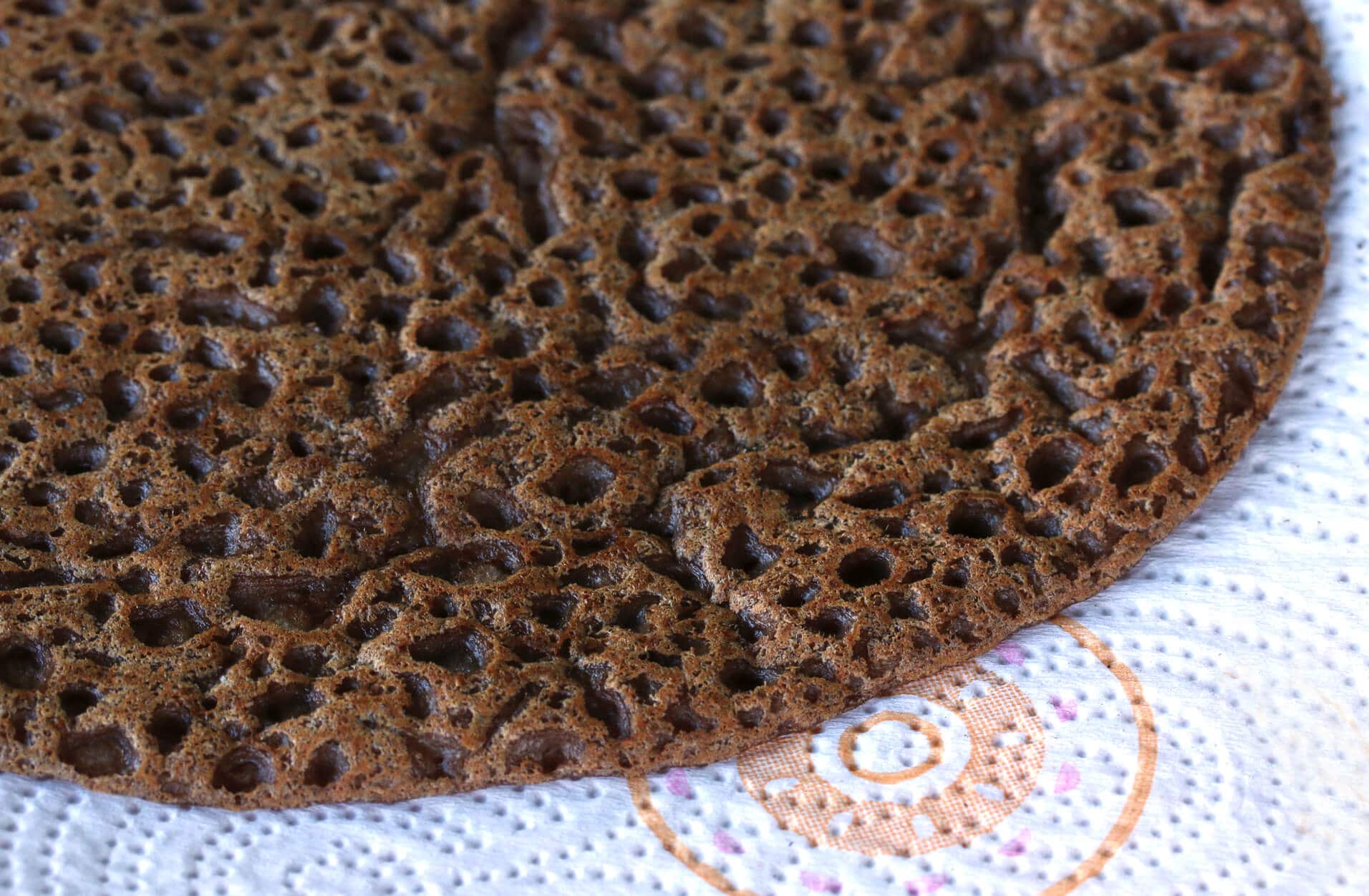
Be sure to also try our authentic Sega Wat, the famous and incredibly delicious Ethiopian spicy beef stew!
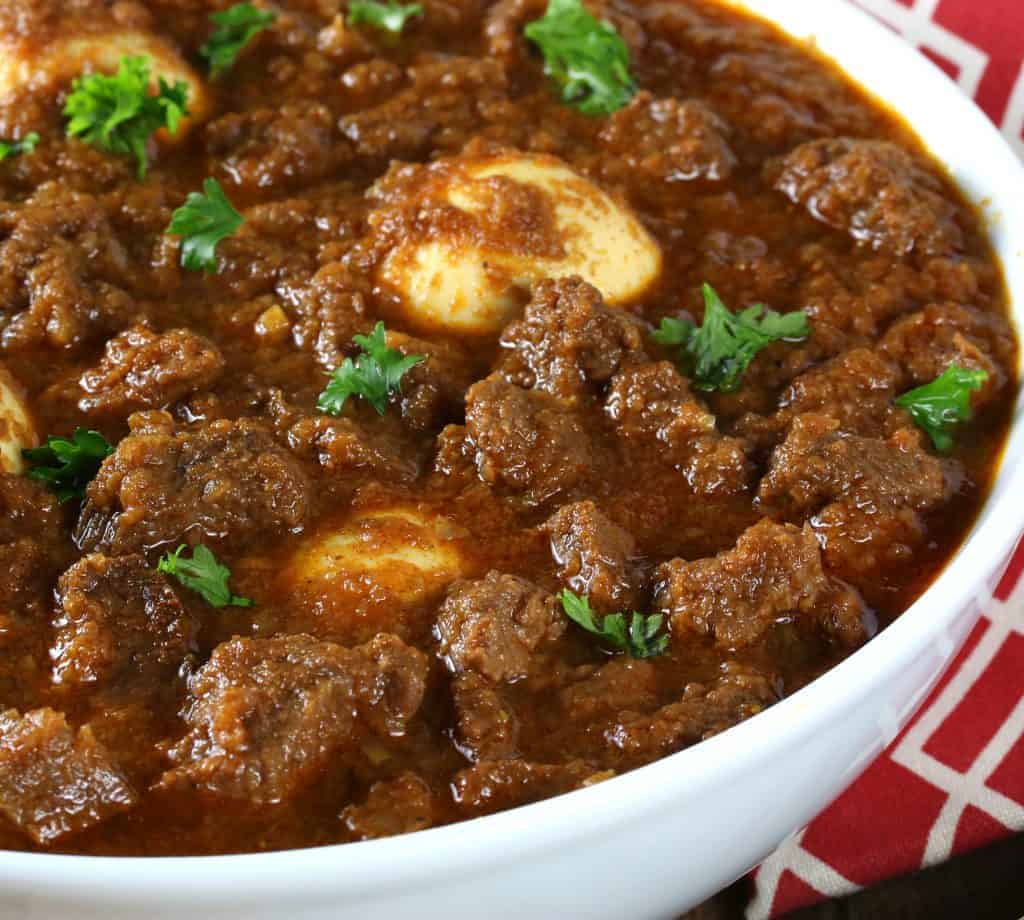
Lastly, for an authentic Ethiopian side dish to serve with your doro wat, try our Gomen (Ethiopian Collard Greens)!
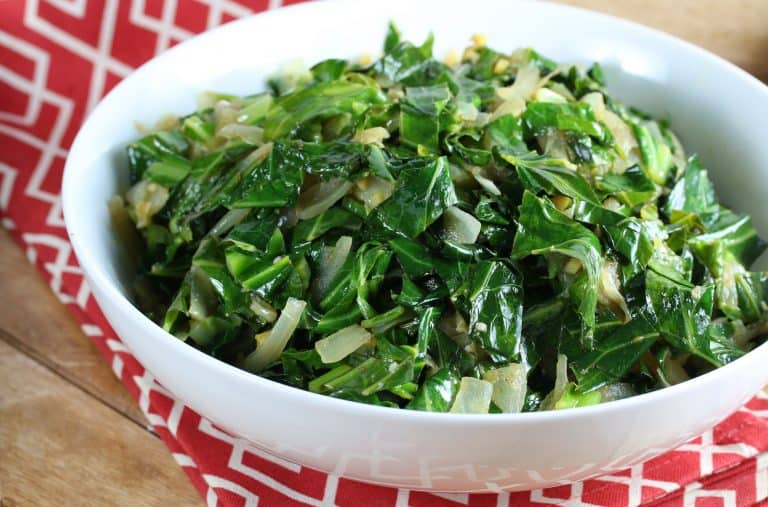
Save This Recipe
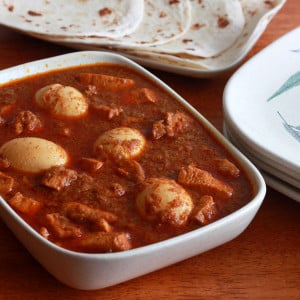
Doro Wat (Ethiopian Spiced Chicken)
Equipment
Ingredients
- 3 lbs chicken thighs , cut into 1 inch pieces, or 3 chicken breasts, cut into 1/2 inch pieces
- 2 tablespoons fresh lemon juice
- 2 tablespoons niter kibbeh
- 2 tablespoons extra virgin olive oil
- 3 cups chopped yellow onions
- 3 tablespoons butter
- 1 tablespoon finely minced garlic
- 1 tablespoon finely minced ginger
- 1/4 cup Ethiopian berbere
- or use HOMEMADE BERBERE (HIGHLY recommended!)
- 1 1/2 teaspoons salt
- 1/2 cup Tej (Ethiopian honey wine) (alternatively you can substitute white wine mixed with 1 teaspoon honey)
- 1 cup chicken stock
- 4 hard-boiled eggs , pierced all over with fork about 1/4 inch deep
Instructions
- Place the onions in a food processor and finely mince them to a chunky puree. Set aside.Place the chicken pieces in a bowl and pour lemon juice over. Let sit at room temperature for at least 30 minutes.
- Heat the niter kibbeh or butter along with the olive oil in a Dutch oven or heavy pot. Add the onions and saute, covered, over low heat for 45 minutes, stirring occasionally.Add the garlic, ginger, and 1 tablespoon butter and continue to saute, covered, for another 20 minutes, stirring occasionally. Add the berbere and the 2 remaining tablespoons of butter and saute, covered, over low heat for another 30 minutes, stirring occasionally.Add the chicken, broth, salt and wine and bring to a boil. Reduce the heat to low, cover, and simmer for 45 minutes, stirring occasionally.Adjust the seasonings, adding more berbere according to heat preference. Add the boiled eggs and simmer on low heat, covered, for another 15 minutes.
- Half or quarter the eggs and arrange on the plates with the stew. Serve hot with injera, bread or rice.
Nutrition
Originally published on The Daring Gourmet August 27, 2013



















Made this last night and it turned out fantastic! Absolutely loved every bite of it!
Awesome, tt, thanks so much!
hi, I made this using your recipe as a framework and then taking a few things from ethiopian spices.com and a youtube vid from howtocookgreatfood. It came out awesome. In USA, did the best i could on the niter kibbeh with indian ghee and spices. Got berbere and fresh injera from ethiopianspices.com Your recipe is great as is, but the one on ethiopianspices.com uses two finishing spices, like we do with Texas Red chili. (an eithiopian expat told me about WOT after trying my Texas Red chili. The process and heat being similar i guess.
Anyway, in the last two minutes of sauteing, you should really try adding 2 tbs mekelesha, and 2 tbs ground cardamom. It adds many sweet and complex layers to this already wicked recipe. I also added 2 pierced bhut jolokia (fresh ghost pepper) floaters to it, squeezed and removed prior to serving. I cant get ethiopian honey wine here either, but Moonlight Meadery Sensual is about as close as it gets. 17$ a bottle, but you are only using less than half cup at a time.
Thank you, this turned out the most wickedly hot thing I have ever cooked that was still edbible by the usually bitching ppl when tasked with eating a bowl of my texas red.
That’s awesome, Clone, thanks so much for your detailed feedback and tips!
Is there a reason why it wouldn’t have the reddish color? I followed the instructions exactly as indicated above (even had a friend with me to validate as we made this together). I even added additional Berere.
Hi Ed, I’d say it’s more brown than it is red, a reddish-brown. The color comes from the Berbere so that will vary from brand to brand.
Made this last night, including niter kibbeh and berbere. Followed the recipe to the letter and what I ended up with was nothing short of incredible, and rivaled the Doro Wat at the new ethiopian restaurant in town here. Didn’t have time to make injera but have enough curry left over for another meal so will definitely make it for next time. This one’s going into the recipe book! Cheers
That’s fantastic, Dan, I’m so happy to hear that – thank you!
Hi Kimberly, is there anything that I can substitute from the honey wine as we are Muslim 😀 I’m a Filipino married to a guy born in Djibouti and most of his relatives are Ethiopian. This guy loves spicy food so much that I couldnt even look at him whenever time he showered his food with heaps chilli powder 😂 and now not surprisingly tho, I’m slowly going in the same path haha. We’ve got 4 kids all under 5 which are half asian and half african. Unusual combination but I wouldnt mind them learning how to eat this kind of authentic dishes from Ethiopia.
Hi Clarisse! I agree, your kids should definitely experience Ethiopian and Filipino dishes to further appreciate their heritage. For the 1/2 cup white wine, I’d substitute 1/4 cup white grape juice and 1/4 cup chicken broth. Happy cooking and let us know how it goes!
I’ve tried a few versions of this dish. Your version and instructions are on point! I only subbed whole thighs for the boneless/skinless, but this rocks. :-) My husband picked up some good quality berbere from an Ethiopian market when he was in the city. The flavors finally melded right.
(Now, if I can only get the injera down.. lol)
Thanks for the recipe!!
Woohooo!! I’m so happy to hear that, Tess, thanks for the feedback! Bone-in/skin-on chicken will always yield the most flavor, so that was a good call. And the injera, yes…I’ve been meaning to post my recipe for it – I need to get on that.
Thank you! I think I’ll try that 😊
My husband and I just went for Ethiopian last night. We were so excited because the closest Ethiopian restaurant we had (1 1/2 hours away), closed several years ago, so we had been deprived of delicious Ethipoian food for quite some time. We had doro wat and I remembered how much I loved it. The version we ate had a slight kick, but was not overly spicy. I would like to order the berbere from Amazon that you mentioned, but am a little concerned that it might be too spicy. I don’t have an overly high threshold for spicy heat. Any recommendations?
Hi Julie! Yes, that’s a tough one. Without actually sampling the different brands it’s hard to know which ones are going to be really hot or on the milder side. If you have the spices on hand you can consider making your own. Here’s my recipe for Berbere and you can simply omit the chilies to eliminate the heat, or at least cut back on them.